|
|
|
|
.
Paulina Connector
 |
||||||||||||||||||||
|
Legend:
Click on a station name to see that station's profile (where available) |
|
|
|
|
.
Paulina Connector
 |
||||||||||||||||||||
|
Legend:
Click on a station name to see that station's profile (where available) |
Service Notes:
|
Dates of Abandonment and Reactivation:.. |
1951 (Evergreen to Congress, enters nonrevenue service) |
|
1954 (Lake to Congress, reactivated for revenue service) |
|
|
1958 (Lake to Congress, resumes nonrevenue service) |
|
|
1964 (Evergreen to Lake, abandoned) |
|
| 2006 (Lake to Congress, reactivated for revenue service) |
History:
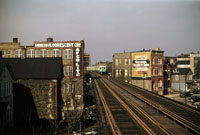 The old Northwest branch elevated is seen looking north from the Division/Paulina station on February 24, 1951, as a revenue-service train of new 6000-series cars heads around the curve onto the Milwaukee Avenue elevated. It is the last day for operation via this alignment; the Dearborn Subway opened the next day. For a larger view, click here. (Photo by Henry M. Stange, courtesy of the Krambles-Peterson Archive) |
What is now the Paulina Connector -- a north-south stretch of trackage along Paulina Avenue (1700W) between Congress Parkway (500S) and Lake Street (200N) -- actually represents a remnant of the Metropolitan Elevated's Northwest branch.
This stretch of track, as well as a portion north from Lake Street to Evergreen and Milwaukee at about 1300N which is now gone, has a long history of switching between being in revenue service and being used for nonrevenue purposes, as well as piecemeal abandonment and demolition followed by partial reconstruction and reactivation for regular passenger service.
Early History
The Metropolitan West Side Elevated Railroad Company -- more commonly referred to as 'the Met' -- built their Northwest branch in 1895 as part of its vast network of lines on the West and Northwest Sides. Northwest Side trains originally took a more circuitous route to and from downtown than today, predating the construction of the Milwaukee-Dearborn Subway. Heading outbound from the Loop, trains traversed the Met's four-track main line paralleling Van Buren Street to Marshfield Junction, where the four-track line split into three two-track branches. The Northwest branch headed due north parallel to Paulina Avenue to Milwaukee Avenue near around Evergreen Street, then turned northwest paralleling Milwaukee Avenue. The Northwest service continued northwest along Milwaukee to a terminal at Logan Square, near Kedzie and Logan Boulevard. The portion of the Northwest branch along Paulina Street between Congress (500S) and Evergreen (1332N) -- just under half of the original route's length -- is what became the Paulina Connector. Today, less than half this length remains standing and in use.
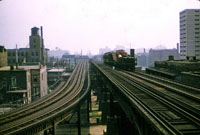 That same work train seen above right on July 25, 1955, has passed through Lake Transfer on its way south. This view, looking south from the abandoned upper-level Lake Transfer platform, shows the 1954--mid-60s configuration of the Connector, with the ramp to the Lake Line (still extant, at left) relative to the original Met Northwest branch (at right). For a larger view, click here. (Photo by Barney L. Stone, courtesy of the Krambles-Peterson Archive) |
As opened in 1895, the Northwest branch had nine stations: Logan Square terminal, California, Western, Damen, Division, Chicago, Grand, Lake, and Madison, the latter five of which laid on what would become the Connector. The station houses were typical of Met designs on the Northwest and Garfield Park branches. Built by the Jonathan Clark & Sons Company for the general contractor, Alfred Walcott, the stations were designed by the engineering staff of the Metropolitan company. Constructed of red pressed brick with stone sills and foundations, their vernacular style might best be described as Queen Anne-influenced with some Romanesque features. The stations' design was highlighted by a semicircular bay/portico, a lattice pattern in the brick cornice, extensive terra cotta work including the word "entrance" above one door in the portico and "exit" above the other (although there is nothing to force ingress from one and egress from the other), dentals above the doors' story lights, and carved wooden beads flush with the building between the wooden brackets which support a wooden canopy over the portico. All of the stations had dual side platforms, with canopies and railings typical of all Met stations: Designed into the railings were larger cast iron square plates with a stylized diamond design. The stairs and platforms were constructed of wood on a steel structure. Each platform had a short canopy in the center of the platform, covering the stairs and a small waiting area. The canopy frame was iron, with arched latticed supports and bracketed rafters, and hipped roofs of corrugated tin.
When the "L" consolidated (somewhat) under the banner of the Chicago Elevated Railways, crosstown service and universal transfers between lines were instituted, and the ordinance required the Metropolitan Elevated and the Chicago & Oak Park Elevated build a transfer station where their lines crossed at Lake and Paulina. Since the Met already had a Lake Street station at that location, only the C&OP had to built platforms and connecting stairs. By mid-November 1913, the station was opened and was re-christened Lake Street Transfer.
From Northwest Branch to Paulina Connector
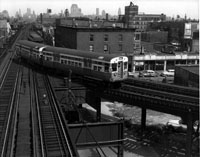
For just over four years while the new Congress Line was being constructed, Douglas trains were diverted via the Lake Street Line to gain access to the Loop using a new connection to the Lake Line built at Paulina east of Lake Street Transfer station. In this 1954 view, a Douglas train of 6000s turns south from Lake Street at Paulina Junction on their way out to Cicero-Berwyn Terminal. For a larger view, click here. (Photo from the CTA Collection) |
Service continued on the Northwest (aka Logan Square) branch largely unchanged until the CTA era. On February 25, 1951, the Milwaukee-Dearborn Subway opened, connecting the Logan Square branch with downtown more directly. At this point, the north-south section of the old Northwest branch became nonrevenue trackage known as the Paulina Connector. A connection between the Milwaukee Elevated and Paulina Connector remained at Evergreen for several years, as the connector was the only connection between the Milwaukee Line (as the newly-independent portion of the Northwest branch along Milwaukee Avenue became known) and the rest of the system and was used for nonrevenue equipment moves.
Part of the connector was reactivated for passenger use as a result of the construction of the new Congress Line in the median of the Congress Street Superhighway (now the Eisenhower Expressway) to replace the old Garfield Park elevated. This construction project was complicated because the CTA wanted to keep some measure of Garfield service in operation for the duration. It was additionally complex because the Douglas branch reached downtown via the Metropolitan Division main line, which was part of the Garfield alignment and which had to be removed to construct the highway and the Congress Line. By spring 1954, the Met main line elevated had to be taken out of service. The Garfield Line was running on a nonstop temporary grade-level alignment as far east as Aberdeen Street, but this arrangement would have been less than satisfactory for the Douglas operation. So, on April 4, 1954, the CTA reactivated a section of the Paulina Connector between Marshfield and Lake. Marshfield Junction was removed in favor of a straight connection from the Douglas to the Connector and a new connection was built from the Connector to the Lake Street elevated adjacent to the flyer-over and abandoned Lake Street Transfer station where the two crossed. The short, curved connection met the Connector at Washington Junction and hooked into the Lake Line at Paulina Junction. Douglas trains would now access the Loop via this connection over the Paulina Connector and Lake Street Route. At the same time, the old northbound track on the Connector was taken out of service from Lake Street to Division Street, as it was decided that two tracks were not needed for only occasional equipment moves.

A crew using a crane car finishes removing the decommissioned northbound track on Paulina Connector on February 4, 1957. For a larger view, click here. (CTA photo) |
In May, the CTA began automatic operation of Paulina Junction, with trains using a device called a Train Identification Coil. This was an electronic device carried by the lead car of each Douglas train. The motorman obtained the coil before the beginning of his run from the station clerk when going on duty and returned it when going off-duty (unless directly relieved by a Motorman requiring use of the coil). The motorman inserted the coil in a bracket mounted on the right front of the train. As a train approached the junction, an electronic device (e.g. the coil) passed in front of a trackside electronic device which automatically set the proper switches for the train. Since only Douglas trains carried the coils, the presence of a coil set the switch for the Paulina Connector. Otherwise, the switch was aligned for the Lake Route by default. If the correct route fails to be automatically set by the transmitter, the Motorman could manually set the route by operating levers on the wayside route selector. This system was later used at Loomis Junction, where the Douglas would connect to the Congress Line when the later was completed.
The portion of the Paulina Connector between the Milwaukee Elevated at Evergreen and the section south of Washington Junction that was being used temporarily by Douglas trains was still important despite not being used in regular revenue service, since it was the only connection between the Logan Square Line (the old Milwaukee Elevated and the new Milwaukee-Dearborn Subway) and the rest of the "L" system. However, since only the occasional work train, railcar transfer, and fantrip, the CTA decided that it was not necessary to maintain a double-track line there. On January 7, 1957, the northbound track was removed from service between Washington Junction and the crossover south of Division/Paulina, retaining former the southbound track for bidirectional use.
By the summer of 1958, construction of the new Congress Line was largely complete. As part of the project, a new ramp was designed and built in the vicinity of Paulina Street that connected the Douglas elevated with the median-level Congress Line. On June 22, 1958, the Congress Line officially opened. Henceforth, Douglas trains would be rerouted via this ramp to the Congress Line at Loomis Junction. Operations of Douglas trains via the Paulina Connector and Lake Street elevated were discontinued. The Paulina Connector was removed from revenue service once again, though its entire length from Congress to Evergreen remained for the time, now with three connections to the rest of the system: Evergreen Junction (at the Milwaukee Elevated), Washington Junction (where it connected to the Lake Line) and Harrison Junction (at the top of the new ramp between the Douglas and Congress lines).
Scaling Down in Nonrevenue Service
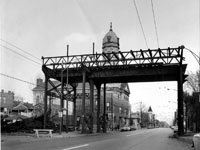 Dismantling of the Paulina Connector between Washington Junction and Evergreen Junction has significantly advanced, with only a few sections of structure still standing. This disconnected span straddles Grand Avenue at Hermitage on October 29, 1964. The stringers for the station platform are still attached to the structure. For a larger view, click here. (CTA photo) |
In the years after the Congress Line opened, very few trains used the portion of the Paulina Connector north of Lake Street. A couple of fan trips used it, and a work train or two every now and then. Finally, in August 1964, it was decided to remove the portion of the Paulina Connector between Washington Junction and Evergreen Junction from service in preparation for demolition. Demolition was completed that year.
In June 1972, the Connector was further downgraded when the southbound track was removed from service between Lake Street and the crossover at Madison. Now, the Paulina Connector would be operated as a single track for its entire length, on the northbound track between Lake and Madison and on the old southbound track between Madison and Harrison. The entire width of the structure remained, however, in parts covered with wooden footwalks and signal equipment.
Renovation of the Connector
For many years, plans were periodically advanced to reactivate the Paulina Connector for regular passenger service, perhaps as a shuttle or part of an existing route, but nothing came of these ideas. The plan that changed all that was the CTA's scheme for the proposed Circle Line, a new circumferential route around downtown at about 2 miles out from the city center. According to the conceptual plan put forth in 2002, the Paulina Connector would represent a portion of the west leg of this proposed route. The trackage was also beginning to age and would need rehabilitation anyway, as it serves as a vital (and the only) link between the Blue Line and the rest of the "L" system for equipment transfers. So, at their regular monthly board meeting on Wednesday, January 8, 2003, the CTA Board approved a plan to renovate the 107-year-old Paulina Connector track.
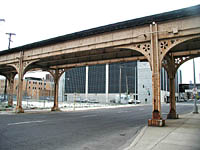 Like other Met "L" crossings over streets in the park boulevard system, the overpass at Jackson Boulevard is decorated with ornamental brackets to make it more aesthetically pleasing, as seen in this April 2003 view. The historic brackets will not be retained when the structure is rebuilt. For a larger view, click here. (Photo by Graham Garfield) |
The Connector was completely rebuilt from head to toe, with new concrete caissons and columns and new steel spans and stringers (a la the Douglas renovation between Wood Curve and Kildare). Almost none of the original steel structure remains. The only parts not being completely rebuilt are from Washington to Paulina Junction and over the Eisenhower Expressway, as these parts are newer and in good condition. The entire Connector got new track, ties, signals, and communications equipment. No stations are planned for the structural rehabilitation project, although stations at Madison-United Center and Van Buren-Medical Center (for Douglas/Congress transfers) were suggested in the Circle Line conceptual plan. It is unfortunate that the renovation of the connector will not include the retention of the original elevated structure -- especially the highly ornate portion at the Jackson Boulevard crossing -- as there is now relatively little of the original 1895-vintage Metropolitan Elevated structure left with the replacement of most of the Douglas branch as well.
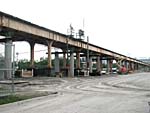 New columns, identical in design as those built on the new sections of the Douglas branch, can be seen continuing off into the distance under the existing elevated structure in this view looking south from Madison Street on August 1, 2003. Forms are beginning to be assembled on the nearest columns for the erection of the crossbeams between columns. For a larger view, click here. (Photo by Graham Garfield) |
Early work largely concentrated between Jackson Boulevard and Madison Street. Crews dug caissons, subterranean vertical foundations made of concrete and steel rebar that support the new concrete columns, underneath the existing steel elevated structure. During the summer, crews dug footings underneath the existing steel elevated structure north of Adams Street, mostly around Madison and Washington. By July, new columns began to be erected, first by installing prefabricated rebar skeletons in the footings, then erecting a mold around the rebar, and finally pouring in concrete to create ribbed cast-in-place concrete columns identical to those found on the newly-rebuilt portions of the Douglas branch. By early August, new columns had been erected between Monroe and Washington streets and by September new columns had been installed along most of the portion of the Connector that was to be completely replaced, between Washington and Van Buren. As of late November 2003, all of the new caissons, caisson caps, and columns were installed. Once this was completed, it became possible to begin replacing the spans between columns.
|
Left: Between Monroe and Adams streets, a crane lifts new steel spans into place between the new concrete bents on September 23, 2003, giving a glimpse of what the new Paulina Connector will look like. For a larger view, click here. (Photo by Graham Garfield) Right: Looking south at Madison on September 23, 2003 during the first shutdown, a block's worth of structure has been removed and new steel spans sit next to the new concrete bents waiting to be lifted into place. A section of original 1895 elevated remains on the left as a reminder of what's be replaced. For a larger view, click here. (Photo by Graham Garfield) |
The Connector was taken out of service several times for periods of several days or weeks during 2003 so that spans could be replaced and work could proceed at a more accelerated rate. Because the Connector is only used for equipment transfers, this did not affect regular passenger service. During each of these phases, a section of existing spans and stringers was cut out and removed, with new spans installed in the void left by the removal of the 1895 elevated structure. This process mirrored how the Douglas branch structure was replaced.
The first closure of the Paulina Connector for span replacement was between September 17 and Wednesday morning, October 8, 2003, during which Kiewit-Delgado removed the old elevated structure between Madison and Ogden and replaced structural spans in the same section. The next closure was brief, between October 15 and October 17, 2003. The 0.75 mile Connector shut down for the third time effective Saturday, November 1, 2003 while Kiewit/Delgado renewed tracks and structure spans from Van Buren to Washington. The Connector was reopened on Monday, November 24, 2003. The Connector was taken again out of service on Tuesday December 9, 2003 while Kiewit renewed the tracks and replaced structural spans in the vicinity of Ogden Avenue and was reactivated Tuesday, December 23, 2003.With structural work largely completed in late 2003, work in early 2004 centered on ancillary work, including special trackwork. During April and May, work concentrated largely at Paulina Junction, where the Paulina Connector joins the Lake Street branch of the Green Line a block west of Ashland station. During weekends throughout April and early May, work was performed to replace Paulina Junction's single-track, hand-throw switch connection with a two-track, bidirectional interlocked junction. This work required single track operations on the Green Line through the work zone. In late May, work began on the south end of the Connector, installing new trackwork at Harrison Junction where the line meets the Cermak (Douglas) branch.
Final work was completed by January 2005, the same time as the Douglas Reconstruction Project. Punchlist work continued for several months.
Revenue Reactivation: The Pink Line
In Summer 2004, the Chicago Tribune reported that the CTA was studying the concept of rerouting some or all Cermak (Douglas) branch trains to the Loop Elevated rather than via the Dearborn Subway to the Northwest Side and O'Hare. Rerouted trains from 54/Cermak would leave the Cermak branch at Harrison and reach the Loop via the renovated Paulina Connector and the Lake Street branch of the Green Line.
The concept of rerouting Cermak trains via the Connector, Green Line, and Loop were one part of the highly-conceptual Circle Line plan the CTA publicized in 2002, although the two concepts are not dependent on one another or inextricably linked as some members of the public have claimed. (Note: It must also be recognized that the Circle Line concept publicized in 2002 was merely conceptual and is not a finished plan. It is required to undergo the federally-mandated Alternatives Analysis process.) The main drive behind rerouting Cermak trains via the Loop and disconnecting the branch from the rest of the Blue Line lies with the ability to schedule trains independently based on demand and travel patterns. Presently, by acting as a branch of the Blue Line, service levels are constrained to be half the number of Blue Line trains run north of Loomis Junction.
Ironically, the proposed reroute would resume a pattern of service used between 1954 and 1958 when Douglas trains accessed downtown via the Paulina line and Lake branch while the Congress branch and Eisenhower Expressway were under construction, the last time the Paulina Connector was used in scheduled passenger service.
The concept as publicized in 2004 elicited protests from residents of the Lawndale, Little Village, and Pilsen neighborhoods, some of whom did not want to lose a one-seat ride to those areas served by the Blue Line, and many of whom were convinced that the reroute would somehow guarantee less service on the branch. CTA and Daley administration officials, on the other hand, argued that the reroute would provide better transit options to communities undergoing revitalization by providing a faster ride downtown via the Paulina Connector and Green Line, and by allowing the CTA to add service to the branch, something not feasible without completely disrupting the rest of the Blue Line's schedule and requiring a number of railcars that simply are not on hand.
Ultimately, amid a budget crisis and calls to instead concentrate on restoring weekend service to the Cermak branch (which the CTA did effective January 1, 2005), the CTA dropped the 54th-Loop route concept for a time. But the idea was not abandoned.
The CTA conducted a West Side Corridor Study with nine interactive workshops in July and August 2004 that brought CTA and West Side residents together to discuss how to enhance service. The study evaluated West Side and west suburban rail and bus service to develop a comprehensive picture of the service needs of the communities.
On November 9, 2005, the Chicago Transit Board directed staff to begin community meetings on the enhancements developed in the workshops. In January 2006, the CTA held three community meetings to discuss the findings of its West Side Corridor Study and obtain public comment.
The proposal to reroute Cermak branch trains to the Loop via the Green Line and Connector generated dozens of comments at the community meetings, more than about any of the 10 proposals to improve CTA bus and rail service on the West Side and western suburbs. Community activists still feared the proposal would adversely impact Cermak branch riders because, although the new route could shorten the trip to Clark/Lake by 8 to 10 minutes and enhance connections to the Orange, Brown, Green and Purple lines, the route would bypass several stops in the West and South Loop areas and eliminate the one-seat ride to the Northwest Side.
CTA officials say the proposal would increase service on the Forest Park and Cermak branches, because trains would no longer be split between the two routes. With more trains running, waiting times would be reduced, making the Forest Park line a more attractive alternative to the Eisenhower Expressway, the study states. On the Cermak branch, trains would run every 10 minutes versus the current 15-minute intervals, CTA staffers said.
On February 15, 2006, the Chicago Transit Board approved recommendations for both bus and rail service enhancements for the West Side and West Suburbs based on the results of CTA's West Side Corridor Study. The plan includes changes to 14 bus routes and the Cermak (Douglas) branch. As part of a 180-day experiment to begin in Summer 2006, trains from 54/Cermak will be rerouted to travel to and from the Loop via the Paulina Connector and Lake Street branch of the Green Line at all times of operation. To address community concerns, service to the O'Hare branch from 54/Cermak via the Dearborn Subway will be maintained during morning and afternoon rush hours. In addition, bus service on the #7 Harrison will provide connections between UIC's east campus and the Illinois Medical District. Enhanced service to O'Hare will still be possible at other times through a free transfer at Clark/Lake.
The frequency of service on the Forest Park branch of the Blue Line will increase, especially during weekday off-peak hours and weekends. Customers who board trains on the Forest Park branch between Medical Center and Forest Park will benefit from increased frequency of service at all times, including weekends, and improved access to CTA and Pace buses along the route. During rush hour commutes, Loop-bound customers on the Cermak branch will have the choice of the current Blue Line routing via the Dearborn Subway and or elevated service via the Paulina Connector.
Although the 54th-Loop service had at many times over the years been referred to colloquially as the "Silver Line", this name was never the route's officially-adopted moniker. In February 2006, the Chicago Transit Board announced a contest in which Chicagoland students would be allowed to submit nominations for the line's color-coded name. The "Name the Line" contest was open to students in kindergarten through eighth grades and students were asked to submit an essay of 200 words or less explaining why their nominated color is best for the new rail line. Over 500 students participated in the contest and entries were submitted from throughout the CTA service area. The winning student received a $1,000 U.S. Savings EE Bond, received public recognition through car cards on CTA trains and buses, and had the opportunity to be one of the first to ride on the new line. The Chicago Transit Board evaluated the essays and selected the winning entry, which was announced on March 30, 2006: the Pink Line.
Pink Line service began Sunday, June 25, 2006.
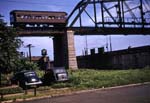 |
cta325.jpg (215k) |
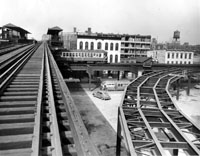 |
ROW@Lake1954.jpg (192k) Looking north from atop the old Met Northwest branch tracks, the new link between the Paulina Connector and the Lake Street "L" is under construction in this early 1954 view. Once completed, Douglas trains will use it to temporarily access the Loop while the new Congress Line is completed. Lake Street Transfer station, closed for about three years, is visible on the left, while a Lake Street train of 4000-series cars emerges from under the old Met "L" on its way to the Loop. (CTA photo) |
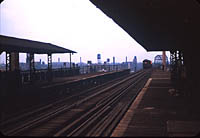
|
laketransfer04.jpg (93k) |
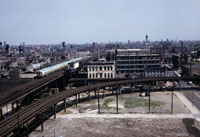 |
ROW@Lake1961.jpg (208k) |
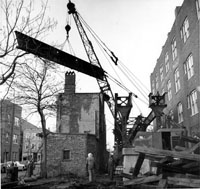 |
ROW@Ohio1964.jpg (265k) A wrecking crew works to demolish the Paulina Connector between Washington and Evergreen, dismantling the steel elevated structure piece by piece. Here, a crane lifts a steel stringer away from the old Metropolitan Elevated structure near Paulina and Ohio on October 29, 1964. The CTA sold the steel for scrap to recover some of the value of the material. After this section was removed, cars and equipment could only be transferred between the Milwaukee branch and the rest of the system via a somewhat circuitous route via the Milwaukee-Dearborn Subway, Congress Line, Douglas branch, Paulina Connector between Harrison and Lake streets, and the Lake Street elevated. (CTA photo) |
 |
tour00l.jpg
(89k) |
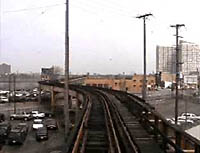 |
ROW@Ogden01.jpg (33k) |
 |
ROW@Madison01.jpg
(30k) |
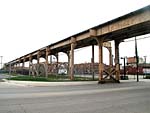 |
ROW@Madison02.jpg
(155k) |
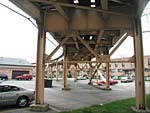 |
ROW@Lake01.jpg
(161k) |
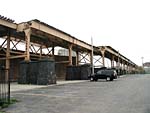 |
ROW@Washington01.jpg
(142k) |
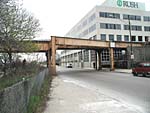 |
ROW@VanBuren01.jpg
(204k) |
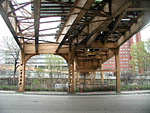 |
ROW@VanBuren02.jpg
(221k) |
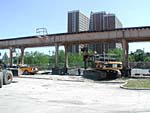 |
ROW@Monroe01.jpg
(176k) |
 |
ROW@Monroe02.jpg
(97k) |
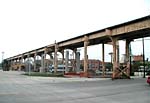 |
ROW@Madison03.jpg
(132k) |
 |
ROW@Madison05.jpg
(123k) |
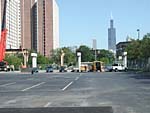 |
ROW@Monroe03.jpg
(168k) |
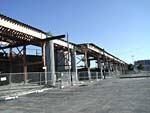 |
ROW@Washington02.jpg
(168k) |
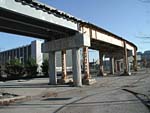 |
ROW@Adams01.jpg
(158k) |
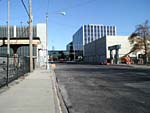 |
ROW@Jackson02.jpg
(166k) |
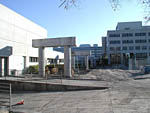 |
ROW@Jackson03.jpg
(142k) |
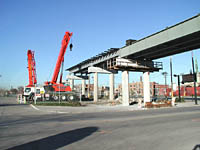 |
ROW@Madison07.jpg
(136k) |
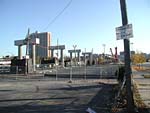 |
ROW@Washington03.jpg
(149k) |
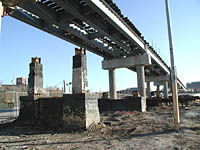 |
ROW@Washington04.jpg
(166k) |
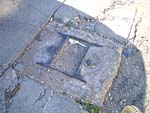 |
ROW@Chicago01.jpg
(214k) |
 |
chicago01.jpg
(146k) |
|
|